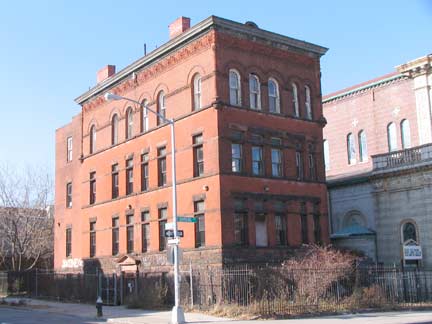
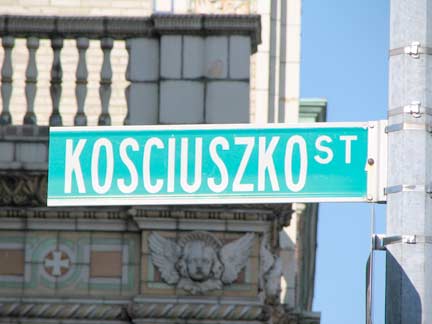
Former St. Ambrose parish house, Tompkins and Kosciuszko Street. General Thaddeus Kosciuszko (1746-1817) specialized in aiding uprisings — as a colonel and later brigadier general during the American Revolution, 1776-1783, where he aided the fortifications at Ticonderoga and arrayed impregnable defenses at Saratoga in New York; served as General Nathaniel Greene’s chief engineer and surveyor, helping liberate the Carolinas and Georgia. After the Revolution he returned to his homeland (now Belarus) to aid the Polish National Force against Imperial Russia and the Kingdom of Prussia in 1794.
The general’s name appears on Kosciuszko Street and Bridge spanning Newtown Creek in Brooklyn, and other locales nationwide and worldwide that sometimes leave the “Z” out of his surname, such as Kosciusko, Mississippi, the birthplace of Oprah Winfrey. In Brooklyn, his name is often mispronounced “Kos-kee OSS ko” though the proper pronunciation is closer to “Ko-SHOOS-ko.”
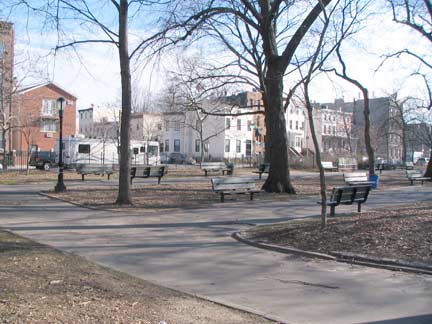
Tompkins Park, renamed Herbert Von King Park in 1985 after a community leader called “The King of Bedford-Stuyvesant,” is one of Brooklyn’s oldest parks — its land was set aside in 1857 and it was developed by Prospect Park’s architects Frederick Olmsted and Calvert Vaux in 1871 as a public square used for gatherings and military reviews. Its Eubie Blake Auditorium, named for the famed ragtime composer, is part of the park’s recreation center built in 1973.
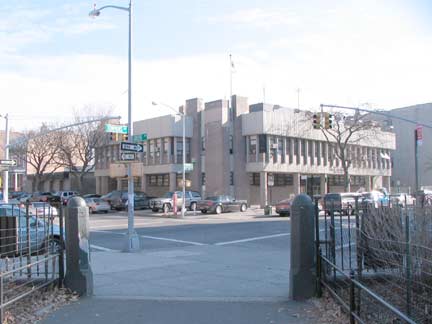
The NYPD 70th Precinct is seen from the southeast side of the park at Greene and Tompkins Avenues.
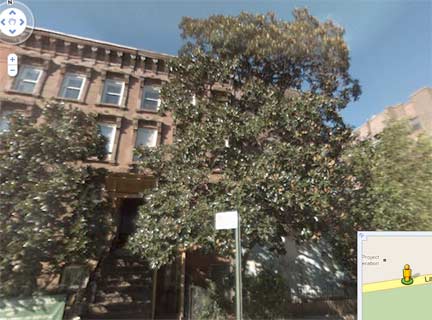
On the midblock of Lafayette Avenue between Tompkins and Marcy, facing the park, is NYC’s only living thing designated by the Landmarks Preservation Commission, the magnolia grandiflora tree planted in 1887, brought from North Carolina. The upkeep of the tree and the environmental center adjacent to it came from an idea by neighborhood activist Hattie Carthan in 1969. This variety of magnolia is usually found only in the deep South.
While Lexington Avenue of Brooklyn might look somewhat nondescript these days, between 1885-1950 it was home to the Lexington Avenue Elevated, which in most part was the longest piece of “the Old Main Line” that ran from York Street and Hudson Avenue generally east and southeast to Cypress Hills, predating the Myrtle Avenue El by 3 years. It closed after years of the IND Crosstown robbed it of passengers for 13 years.
It had a stop at Tompkins Avenue, but it’s not shown in the undated picture from nycsubway.org hat also does not name the station. The el came up to about the 3rd floor windows of the apartment buildings along Lexington Avenue.
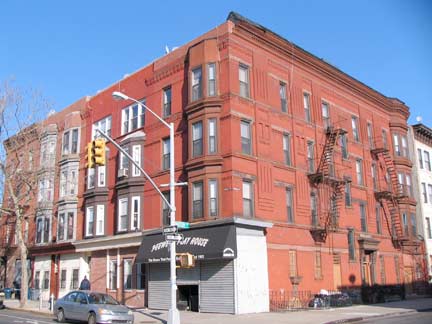
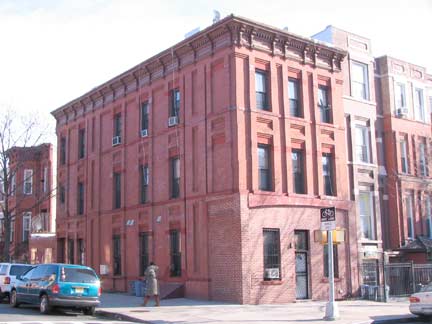
Continuing south along Tompkins Avenue, which, despite not being a major shopping street, once supported the #7 Tompkins Avenue trolley which once plied Division, Harrison, Tompkins, Kingston Avenue and Empire Boulevard from Williamsburg to Prospect Park, you begin, at about Madison Street, to see some magnificent brick residential buildings that helped give Bedford-Stuyvesant a reputation for handsome architecture. The trolley ended service August 24, 1947
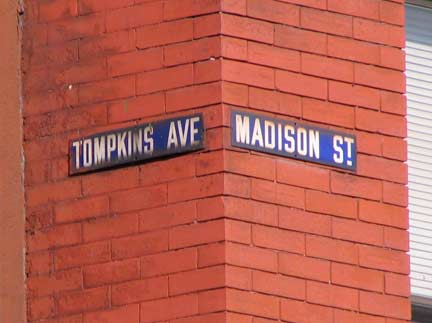
The small blue and white street signs on the buildings were the major means of delineating cross streets unti the 1910s, when “humpback” signs showing the street and its cross street began to be mounted on lampposts.
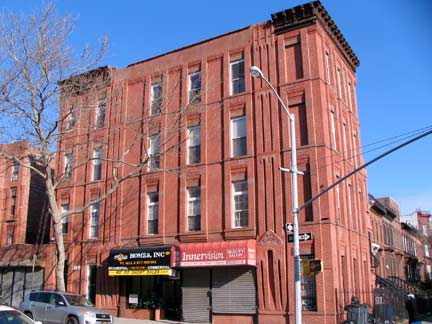
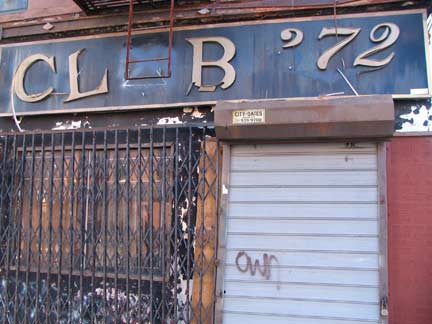
A nicely vertically striated building at Putnam and Tompkins, and the remains of Club 372
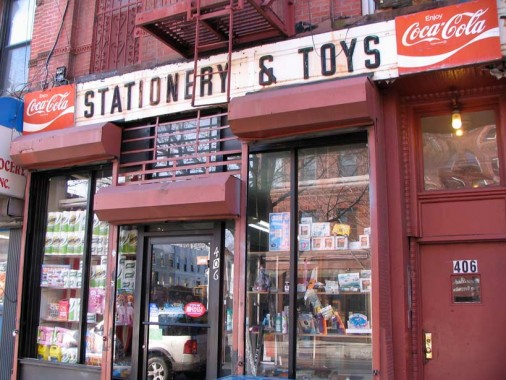
By their convenience stores ye shall know them. I don’t think stationery and toys have been the focus of this corner grocery at Tompkins and Jefferson in a few decades but it’s still old school all the way.
The Good Stuff
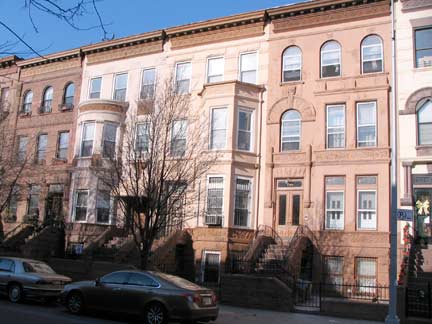

On Hancock Street between Tompkins and Nostrand Avenue are a group of Bedford-Stuyvesant’s most prominent and famed examples of architecture in a neighborhood resplendent with handsome attached homes; these, on Hancock near Tompkins, aren’t quite as praised as those on the west side of the block (see below).
 The most prominent signature on the Declaration of Independence was John Hancock’s, in the Representative from Massachusetts’ capacity as President of the Continental Congress when the document was drawn up. Hancock (1737-1793) had been a prominent shipping merchant prior to the Revolution but his sympathies were with the patriots from the beginning; he was present at the Boston Tea Party in December 1773.
The most prominent signature on the Declaration of Independence was John Hancock’s, in the Representative from Massachusetts’ capacity as President of the Continental Congress when the document was drawn up. Hancock (1737-1793) had been a prominent shipping merchant prior to the Revolution but his sympathies were with the patriots from the beginning; he was present at the Boston Tea Party in December 1773.
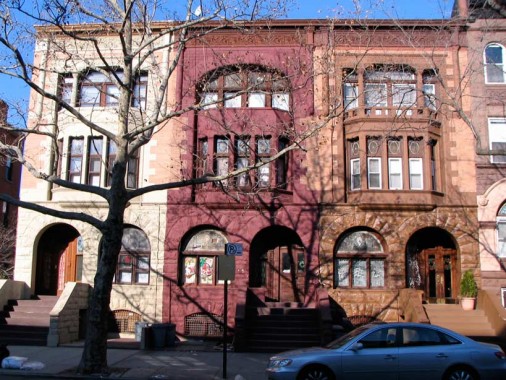
255, 257, 259 Hancock Street, constructed in the 1880s with Montrose W. Morris (1861-1917) the architect. Morris was one of Brooklyn’s foremost architects in the late 19th Century, and his fingerprints are all over Bedford-Stuyvesant especially. When he began his practice he designed his own residence and opened it to the public, so developers could see his techniques. He attracted the attention of Louis Seitz, Jr., for whom he constructed some of the most elegant multifamily residences of all time, in any city, and most can still be seen today in Brooklyn. This group features loggias on the top floors, a feature Morris used frequently.
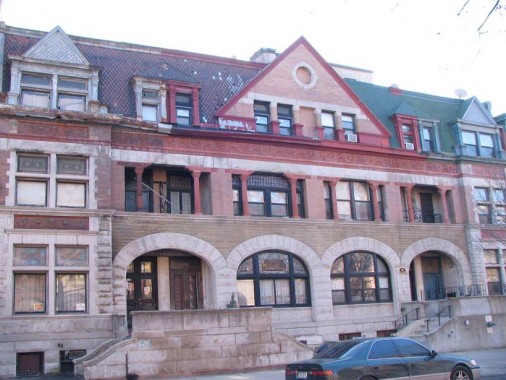
246-252 Hancock Street. The AIA Guide to NYC describes this group thus: “Terra-cotta, stained glass, elliptical arches, and Byzantine columns, mansarded and pedimented against the sky.” Another group by Morris. Francis Morrone, in An Architectural Guidebook to Brooklyn: “The second floors between the pavilions have loggias flanking two window bays, with all four bays having two fluted columns bearing Romanesque capitals.”
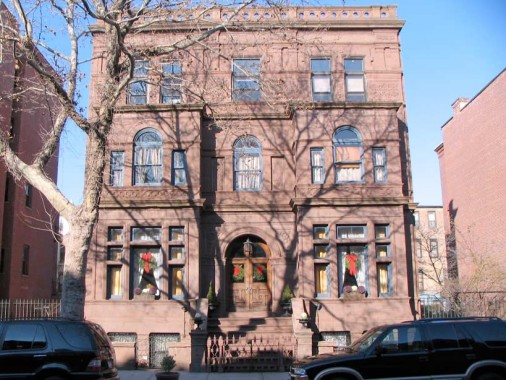
Morrone calls 247 Hancock the “Queen of Hancock Street.” This is an Italian palazzo-style town house Morris built in the 1880s for John C. Kelly, an Irish immigrant who had been an innovator in steamfitting and water meter units. The AIA Guide described it as “crumbling and painted” in 2000, so it’s been spruced up since.
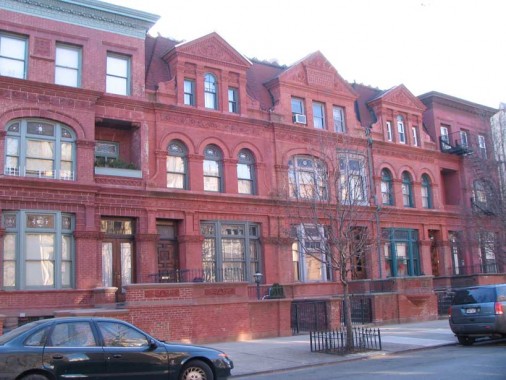
236-244 Hancock Street, yet another Morris, in a building reminiscent in style to the Long Island (now Brooklyn) Historical Society on Clinton and Pierrepont Streets
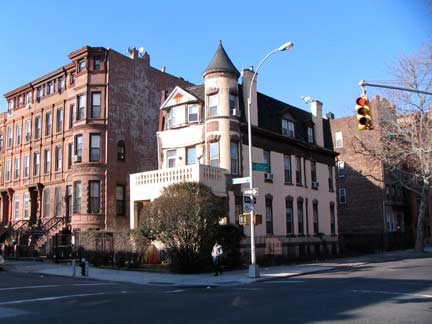
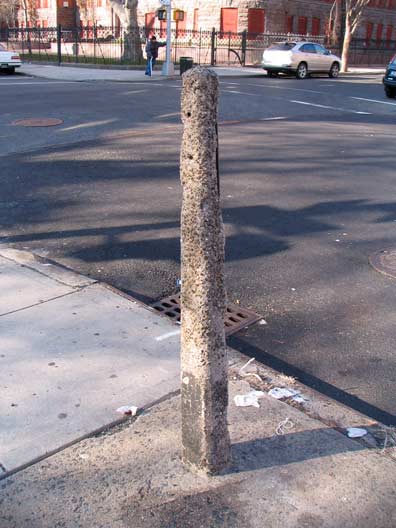
A turreted wonder at the NW corner of Marcy and Jefferson Avenues, and a pebbled concrete pole that used to hold a mini-mailbox at Marcy and Putnam.
Where the boys all went
The monumental Boys’ High School was built from 1891-1892 (was there ever a greater year for NYC architecture than 1891?) James W. Naughton, architect, with a very complementary addition by NYC’s foremost public school architect, C.B. J. Snyder, from 1905-1910, on Marcy between Putnam Avenue and Madison Street. By 1891, Boys’ High had attained such prestige that it was considered meet and proper to construct a landmark building visible throughout its neighborhood. It is visually dynamic, with all manner of turrets, towers, gables and dormers.
When it opened, Boys’ High served just over 780 students. As mid-Brooklyn’s population expanded, the school had to, as well, and Snyder, Naughton’s successor as chief public schools architect built an extension that nicely echoes the original. Compare PS 122, on Harrison Avenue on Page 1 to the much more joyful Boys’ High. The high school is now home to Bedford-Stuyvesant Preparatory High School and Literacy Center. Boys’ High was marvelously restored by architects Beyer Blinder Belle in recent years.
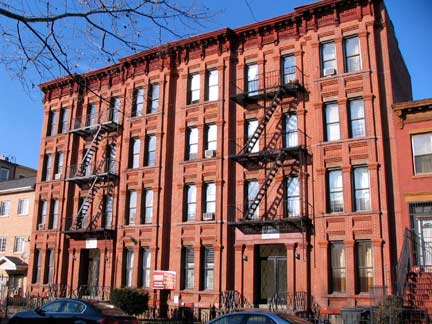
Another recently restored apartment building on Putnam between Marcy and Nostrand Avenues.
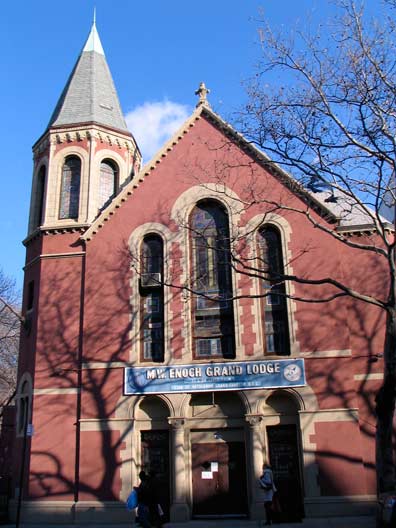
Most Worshipful Enoch (pronounced “ennick”) Mason Grand Lodge (originally Reformed Episcopal Church of the Reconciliation) Nostrand Avenue and Jefferson Avenue.
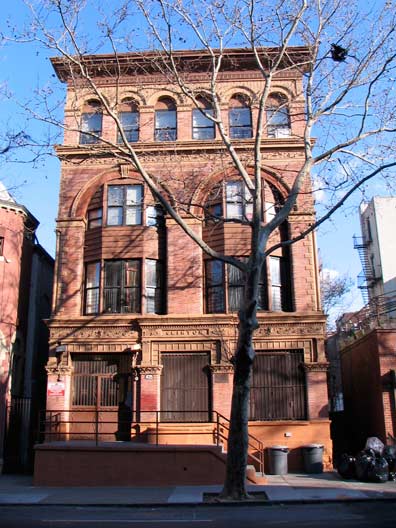
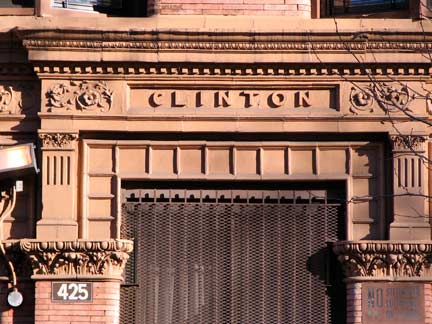
Next door, the Clinton Apartments, both 1890 or so. The Lodge was designed by architects Christopher LaFarge and George Heins, perhaps known best in NYC for designing most of the NYC Subways’ original 28 stations as well as the still under construction Cathedral of St. John the Divine on Cathedral Parkway.
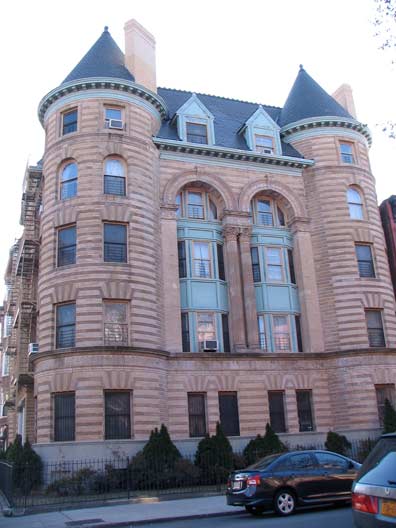
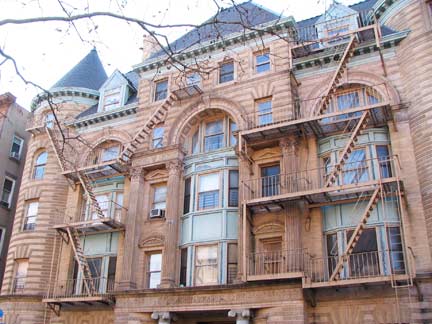
Returning to the prolific Montrose Morris, who did not sacrifice quality for quantity; this is the Renaissance Apartments (1891) on the west side of Nostrand at Hancock Street. This is one of the buildings Louis Seitz commissioned to Morris and we presume he didn’t disappoint. Francis Morrone compares it, with its cylindrical turrets with conical caps, to the NY Cancer Hospital (now converted to condos) on Central Park west and West 104th). It also somewhat resembles the now demolished S.R. Smith Infirmary in New Brighton, Staten Island.
The Alhambra Apartments, west side of Nostrand between Halsey and Macon Streets, is perhaps Montrose Morris’ best known building in Brooklyn. It was the first building Morris built for Seitz. Writing about the Renaissance and the Alhambra, Morrone says “these buildings were the outward expression of the richly and somberly upholstered interior lives of a nascent mercantile and professional middle class that had claimed Brooklyn neighborhoods such as Bedford-Stuyvesant as their own.” The Alhambra was actually built as two buildings connected by arcaded bridges (below right). From the start tenants in the Alhambra enjoyed electric lights, and it originally had a croquet lawn and tennis court. Originally there were 6 apartments per floor, each with 8 or 9 rooms. The beauty of the building was somewhat compromised by the storefronts added in the 1920s.
Girls’ High
James Naughton’s Girls’ High School (1885-1886, addition Snyder 1912) was originally part of Brooklyn’s central Grammar School, as was Boys’ High School. Girls’ High is more modest than Boys’ High but spectacular by today’s standard. It happens to be the oldest building in NYC built as a high school.
The “Girls’ High School’ nameplate must have been added in 1891 because that was the year it became the official title of the school, which is now the NYC Board of Ed Adult Training Center. Alumnae include Congresswoman Shirley Chisholm and singer Lena Horne.
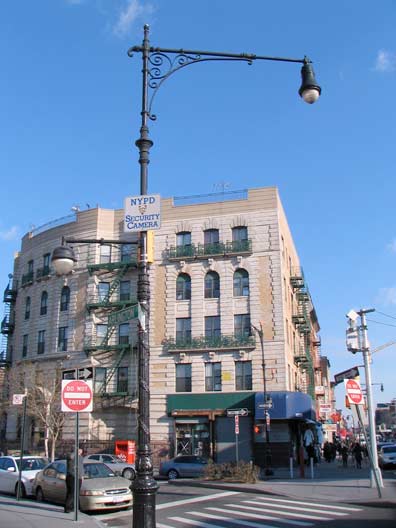
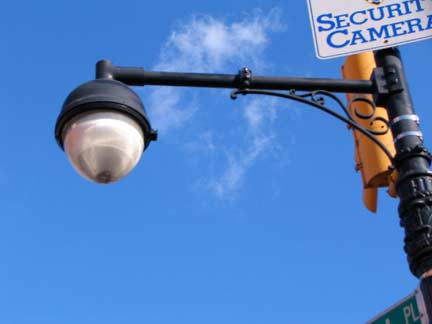
Retro-Corvington lamps have been added along Fulton Street in recent years, with ‘mini-me’ lamps to illuminate the sidewalk. In the background rises the Macon Apartment on Arlington Place and Macon Street.
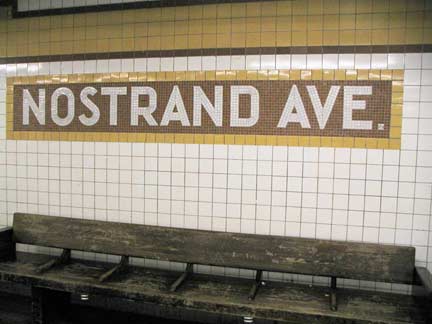
Time to head home on a cold day in December. They may seem a bit same-y to some, but I enjoy the 1930s IND-style colored nameplates. IND stations carry the same color on stations between express stations; the color changes when an express station is encountered. On Fulton Street a number of stations are buff and gold, like Nostrand Avenue.
1/23/11

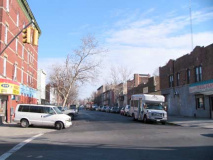
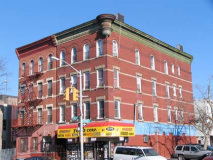
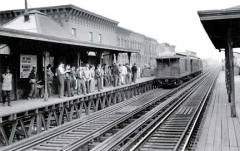
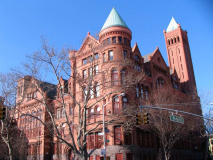
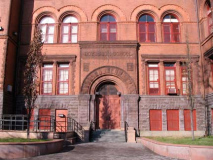

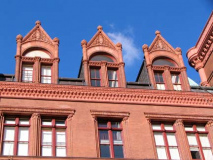
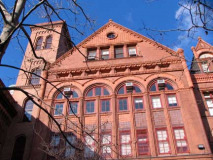
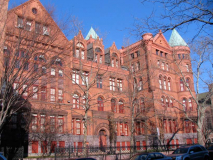
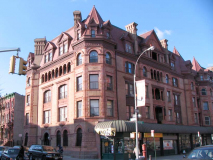
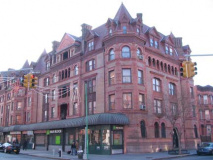
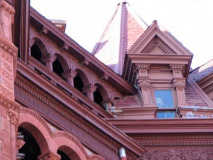
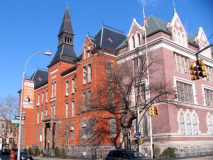
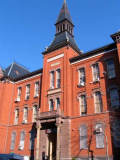
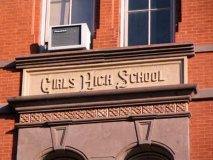
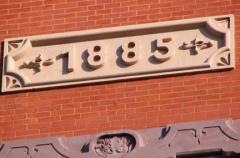
5 comments
I just found this site and have enjoyed it immensely! In the 1940s and 1950s I grew up on Myrtle Avenue, between Thompkins and Throop Streets. I enjoyed all the photos found here! You gave me great pleasure with your shots showing Thompkins Park, the Armory, and even the police station at Vernon and Thompkins — right around the corner from where I lived. I had been searching for Public School 55, on Floyd Street but had no luck. The information on Floyd Street I shared with my dear friend from Kindergarten! No mention of Stockton Street, one block away, where other relatives lived.
I thank you so much for sharing this with us.
Cordially,
Brooke – an Arizona resident now
I went to P.S. 55 it was on
Stockton Street you went from kindergarten to third grade on one side then to Floyd street 4h to 6th grade and you were not allowed to cut through. I have a picture of it on my computer. Do you have any class pictures.? I was there 1947 to 50 I think. rosemarie11727@yahoo.com
That police station on Tompkins and Greene ave is the 79, not the 70
My name is Evelyn Rentas, ( Santiago)
I lived on Tompkins Avenue between Dekalb and Kosciusko 1962-1976. I’ve been searching for Saint Ambrose class pictures, any advice on how I can obtain any? I really enjoyed reading and looking at the pictures, brought back wonderful memories, thank you.
I lived at 69 Macon St 1950 – 1982 moved to VA BEACH Went to PS 93 & JHS 258 HS New Utrecht